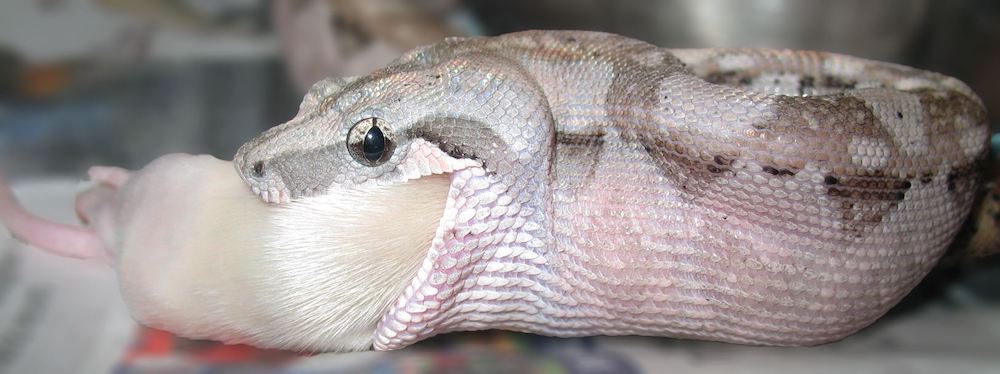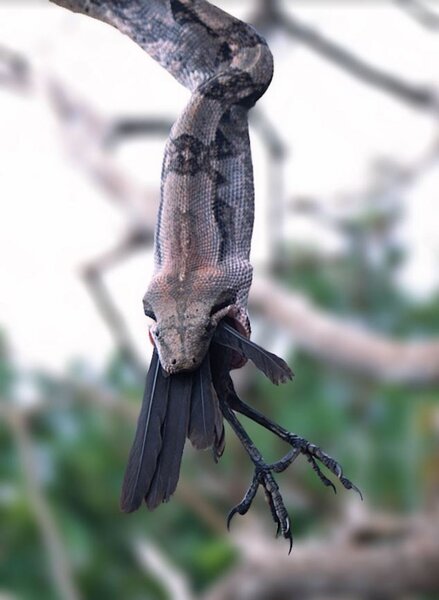Create a free profile to get unlimited access to exclusive videos, sweepstakes, and more!
Boas move their bones around to breathe while squeezing the life out of prey
When's the last time you thought about what your ribs are doing?

Humans have their eating hole in the same place as their breathing hole, which might be considered an example of poor evolutionary design. Certainly, it sometimes results in choking or trouble breathing when snack time doesn’t go as planned, but at least we’re not called upon to swallow food which is larger than our actual heads.
Snakes regularly capture and consume prey which is much larger than they have any business eating, and they do it without the benefit of any additional limbs. Moreover, the muscles they use to constrict their prey are the same muscles they use to breathe. Which raises the question of how they manage not to suffocate while squeezing the life out of their dinner and swallowing it whole.
New research published in the Journal of Experimental Biology takes a hard look at boa constrictors (almost the toughest snake around) and reveals the bone-shifting adjustments they make to keep air flowing through their lungs while they eat. John Capano, from the Department of Ecology and Evolutionary Biology at Brown University, was the lead author of the study.
“Snake lungs are really long, and people didn’t know what the function of the long lung was. There’s a bunch of gas exchange tissue in the front of the lung and then it really abruptly changes to an empty bag in the back of the lung. We thought that back part might be used during constriction or prey ingestion when they have some issues with ventilation,” Capano told SYFY WIRE.
Unlike other terrestrial animals which rely on the diaphragm, a muscle dedicated to respiration, snakes breathe by moving their ribs. In fact, breathing with the ribs is the ancestral form which first emerged when animals adapted to living on land. Most terrestrial species evolved other methods, but snakes and lizards do just fine breathing in the old way. Shifting the ribs creates a vacuum in the lungs in much the same way the diaphragm does in humans, initiating respiration. Crucially, the ribs are also used for locomotion and, in the case of prey acquisition, constriction. The critical question was how they manage to continue breathing while their ribs are otherwise occupied with motion or murder.
“I knew if I could somehow monitor rib motion, we’d see how it’s causing lung ventilation. We used a big X-ray machine to look inside the animals and measure movement of the rib cage,” Capano said.
Simply putting them in the X-ray machine revealed how they breathe while they’re stationary or moving around slightly, but it didn’t answer the question of what happened when they were constricting. To test that, Capano put the snakes inside a blood pressure cuff and applied pressure, simulating the same kind of forces their bodies would be under while constricting.
“I wanted to know, can they change where they’re breathing on demand or is the solution to fire the whole body and move everything and you get what you get? Or do they have spatial control to pick which section they turn on?” Capano said.
The experiments revealed that boa constrictors can, in fact, move their ribs in different body sections independently, depending on what’s required. When one section of the body is involved in constricting prey, another section of the body can handle the lung motions needed for respiration. When swallowing, observations showed that breathing is initiated in the back of the body, then, as the prey moves toward the back, it switches over to the front of the body. All of this is controlled entirely by the intentional movement of the ribs.
“We really focus on what snakes don’t have, but there’s a long serially repeated section of the body they do have, and they’ve done a lot with just that,” Capano said.
Next, researchers want to look at how breathing happens while snakes are moving around in their environment. While slithering, the ribs are engaged with pressing into the ground and it’s possible they cycle respiration between the front and back part of the ribcage as they’re moving.
We’re just glad we don’t have to shift the internal position of our bones around every time we want to go for a jog. Exercising is hard enough as it is without worrying where your bones are at.



























